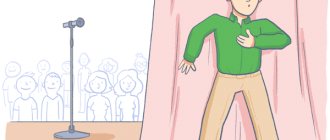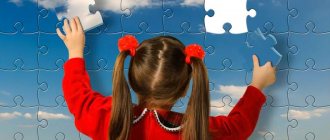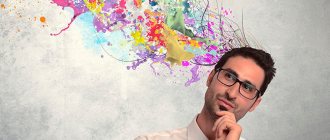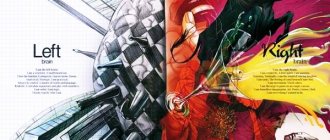Every person living on the planet certainly asks questions about his development at a certain period of his life, but unfortunately, most often the physical aspects of human health and strength come to the fore, but the development of mental capabilities is no less important, and sometimes can play a decisive role in the fate of the individual.
Human brain activity has not been fully studied and definitely consists of many processes that require an individual approach and their own methods of training and stimulation. However, at this stage we will consider such a broad concept as thinking and those effective ways of influencing it, which will lead to the formation of effective thinking in its various forms and directions.
Technologies for the development of thinking
Undoubtedly, to begin to develop, you do not need a lot of financial costs and any equipment as when playing sports, you only need a few free minutes a day (say, 15-30 minutes), consistency and effective use of the allocated time. Undoubtedly, the conditions for the development of thinking do not necessarily require special programs or only the indicated exercises; however, thinking simulators will help you rationally use your time. Their developers implement the latest research in this area for a comprehensive impact on each type of thinking. With this approach, everyone receives an even mental load, without depriving attention of that space of the brain that is rarely used in everyday work.
Types of thinking that need to be systematically developed:
- Boolean
- Abstract
- Creative
- Visually effective
- Visual-figurative
Training
The most effective way to develop thinking in a short time is to undergo training. I present to your attention the course “Development of Thinking” from Vikium.
You will learn:
- make the right decisions with lightning speed;
- clearly argue in disputes and convince;
- construct your speech competently and logically;
- count complex examples in your head with ease.
The course includes:
- thinking development program;
- theoretical video lectures;
- practical exercises and assignments
- simulators for the development of logic
This course will help:
- improve and speed up thinking;
- develop analytical skills;
- think critically in any situation;
- make unconventional decisions.
Logical thinking
This is perhaps the most popular part of the mental process, which is remembered first and many simulators are offered for its development. The approach to this type should be comprehensive, but it is worth understanding that this systematization does not reflect a complete picture of all the processes inherent in logical thinking. Therefore, let us consider those components of the process under study, on which development work will be carried out in the future.
- Analysis is an understanding of the structure of things, the ability to mentally divide something down to the smallest components and find connections between them. Whether it is the structure of living tissue, the chemical composition of a material, or a chain of events leading to one result, analysis will help to understand the essence of what is happening down to the smallest detail.
- Comparison is the ability to accurately highlight all similar and opposite elements of things, events, concepts. Even unrelated objects can have common features or be completely different, and to correctly classify them, it is necessary to develop this ability.
- Synthesis is the creation of one general structure from its individual parts, sometimes in a different order or combination than it was before. This ability extends to both physical and abstract objects, as well as chains of events that can be interpreted in different ways. Training the ability to synthesize is underestimated and important, it helps to see different connections in seemingly obvious things.
- Abstraction is the use of abstract concepts in the thought process to replace specific images. In this case, a person consciously distracts himself from unimportant details in order to see the whole picture.
Methods for developing logical thinking are quite simple and include a lot of exercises, which are not only collected in simulators, but are also available in a separate version to everyone who wants to develop:
- Reading is an easy way to influence your thinking abilities, and the genre and style of the material is not so important. The reader learns to process the information received, analyze it, draw preliminary conclusions, and correct them in the process of obtaining new information. It is difficult to imagine a developing personality who does not read at all; this is a small but very important step in self-development.
- Logic games are an opportunity to combine a pleasant pastime with a useful activity for the mind. There are many such exercises and they are presented both in digital versions and in physical board games.
- Online simulators are the same exciting classes collected in one place, but they already offer an effective, quick analysis of your actions and are aimed at improving your results.
- Logical chains are a simple activity that is accessible even to children; its essence is to, from a chain of pre-written words, reasonably cross out the unnecessary things that are not connected with the rest.
- Logical connection is a task that asks you to find between, at first glance, completely different words, as many facts as possible that unite them.
- Keeping a diary is a very useful habit that allows you to analyze the events that have passed during the day and express them in writing, give them your assessment and suggest the reasons for this result.
- Sentences with unrelated words - as the name suggests, you need to construct a sentence that is as interesting and attractive as possible with several unrelated words that are thought up and written down in advance. The number of such words can regulate the difficulty level of the exercise.
Rest
- Meditation. We have already written about how meditation affects the brain. Let us only recall that regular meditative practice helps to get rid of sudden feelings of anxiety, respond more adequately to physical illness, and also better understand other people.
- Computer games. They shout on TV that children are becoming dumb from playing computer games, that teenagers who spend a lot of time playing Xbox are degenerating. But a professor from the University of Rochester claims that gaming improves multitasking and spatial thinking. In addition, logic computer games cannot be called “stupidizing”.
Abstract thinking
It is often called verbal or verbal-logical, since it operates with words, and from a huge array of words, a person selects the most significant for a given situation and from them composes a short description in his head. In this process, all additional words and concepts that do not carry a key meaning are not taken into account, but only convey color or an emotional component.
Training verbal thinking is important for everyone, but especially for children who still have a lot to learn, and this ability will take the effectiveness and ease of learning to a new level.
This type, like the previous one, operates on several main components:
- Concept – groups of objects united by the same characteristics. In this case, each of the objects individually is not important, but only the key characteristics inherent in all of them.
- Judgment - can be described as a kind of incomplete conclusion, when a certain thought is affirmed and it is taken into account, but it does not cover the whole picture, but only one aspect.
- An inference is a full-fledged conclusion that is drawn based on all the judgments in a given topic.
Several effective exercises for developing abstract thinking:
- Repeat the sentence in other words - during the task, the meaning and details of the sentence should remain unchanged, but not a single word should be repeated. To achieve maximum efficiency, work on one sentence must be repeated as many times as possible, that is, come up with the maximum number of new phrases that convey the same idea.
- Remove an extra word - from a group of pre-prepared words, one does not fit into the general concept, it needs to be found and removed with reason.
- Find differences between pairs of words - the material is also prepared in advance; words grouped into pairs can be completely different, while during training you need to identify as many differences as possible, some of them are obvious, while others will have to be looked for.
- Words with complex letters - having chosen the least common letters in everyday life, you need to come up with as many words as possible using them.
Creative thinking
This is the ability to analyze and process information in a unique way and approach classic problems in a new way. This skill is inherent in every person from the very beginning; you just have to find a way to activate the dormant potential to achieve new results. Not met before. This potential helps not only in creating a new creative product, but also facilitates a person’s practical life, helping to always find a way out of the current situation, even when traditional methods are powerless.
The principles of improvement in this direction are well known and very popular at this time, but this does not mean that many people use them in their practice. All of them are based on the need to regularly meet new people, expand your horizons, and visit new places and activities. Constant, continuous learning on any scale is an essential component of success in this business, and improvisation and the desire for an ideal result will not keep you waiting long for excellent results.
To develop your creative qualities, you should pay attention to a few simple but effective exercises:
- Reproduction of images - to do this, remember several people you met throughout the day, imagine them in as much detail as possible, down to the smallest wrinkle on their face. Now make this image change its mood and facial expressions, smile at you, get angry or upset. To complicate this task, remember the nearest holiday or event where a group of people gathered. Recreate in your memory all the smallest details, including what each of them wore, the music that played, the taste of the treats and the smells in the air. You can also learn to recreate separate groups of images, according to one characteristic, for example, by color - you need to remember as many green vegetables as possible, then yellow, then red, or by taste - sweet, bitter, sour.
- Training your imagination is a favorite game for children, but it can also be a useful exercise for adults. Creating non-existent images in your head allows you to see previously familiar things from a completely different angle. This has a positive effect on the ability to find a way out of any situation and develops creativity in approaching any task. To train creative imagination, you need to imagine an object or concept or sign that is not alive in the real world, is not a person and is quite unambiguous in its essence. Next, in your imagination, you need to endow him with character, habits, good or evil disposition, favorite activities, why he does this or acts this way, imagine what this object would like to do, where he would prefer to live, with whom to be friends. At the very beginning of such exercises, there will be a slight conflict with the logical part of thinking, and this activity will seem stupid and useless to you, but this is an important tool in the development of creative imagination and creativity.
- Fiction stories are an exciting and rewarding activity that can also be fun. To begin with, come up with an incredible situation in a few words, for example: “dinosaurs suddenly came to life” or “snails enslaved the world”, and try to develop the theme as extensively as possible. Address not only the issues of one individual in such a situation, but also how it affected the world globally.
- Imagining a probable future is one of the tools for developing creativity in your personality, because you can imagine your future as plausible as possible, but at the same time the way you want. To make the task more specific, choose an exercise such as a letter to your great-great-grandchildren or a list of things that you would like to pass on to your descendants. You can also come up with a shopping checklist for the zombie apocalypse or the day when robots take over the world. Although such a process seems ridiculous, it helps to connect logic and imagination, and in your thinking everything that happens is reasoned and has a basis.
Find a personalized way to memorize and solve problems
We are all different, and each person has his own unique style of thinking and remembering information. Someone will be able to develop memory speed in a few weeks, while another person will need several months, however, this does not mean that you have to stop.
Everyone's speed of memorization is also different. One person needs only a single repetition of the material, while another needs to watch or read it several times.
Analyze how you remember information. The memorization method will help you find the most effective method of assimilation of information. People are divided into three types:
- Visual people - they often operate with images.
- Auditory - They remember better what they hear.
- Kinesthetic learners - sensations are important to them.
Having determined your leading type, you can choose the most convenient method of memorization. Remember how it is more convenient for you to perceive information - reading or listening. Do emotions, as well as the ability to touch a thing with your hands, affect the speed of memorization?
Use this system. However, we should not forget about others, they should also be developed, and then thinking becomes more productive and memory is stronger.
Visual-effective thinking
This type of thought process is a product of the left hemisphere and consists of creating a copy of an existing object or object in the mind and identifying its properties and possible benefits, first in one’s imagination for subsequent application in reality. For simplicity, you can imagine a small child who, looking at an object and touching it, imagines where it will fit, whether it is edible or not, whether it can be thrown or hit with it. Adults also use this technique, going over in their heads the possible useful properties of an object, they imagine it in action and make a preliminary conclusion about its suitability for such use. This is clearly expressed when an adult is looking for something to replace a missing part or what to make it from.
This process is trained in all games where various combinations of moves are calculated, for example in chess or checkers, but there are also specially designed exercises:
- Determining the characteristics of an object - choose one of the objects lying in your room and try to imagine its weight. After that, check how it feels by picking it up and determine whether it’s how you imagined it. Also mentally determine its area and try to figure out the relationship with the area of your room. How many of these items will fit in one layer, but what about the volume? If you filled the whole room with such objects, how many would there be?
- Puzzles – both physical and virtual puzzles help develop visual and effective thinking. They force you to first perform actions several steps forward in your imagination, and then check the results in practice.
- A construction set is not only a desirable toy for children, but also a great way to come up with many different shapes and try to assemble them. This is a great workout for your brain, and the more details in the constructor, the better.
- Modeling figures , like a construction set, helps bring to life an object you previously conceived and try to make it exactly the way you imagined it. If you have the desire and time for such an activity, be sure to try it.
Visual-figurative thinking
This process helps in solving real-life problems and tasks without involving physical actions, but only with the help of images created from real objects in the head. Unlike creative imagination, objects created in the head actually exist and all that remains is to choose options for using them to solve the problem as effectively as possible.
An important task when training this process is to develop the ability to recreate accurate images of existing objects; several exercises have been selected for this:
- Reproducing a seen object in detail trains attentiveness and allows you to notice and retain more details in your memory in the future. To do this, remember any object or living object and try to describe it for yourself as accurately as possible, how many dots are on it, what color is it, what is the nature of the surface, are there corners and how many of them? The more details you can recreate, the more effectively your spatial thinking will be trained, bringing objects from the real world into your mental space.
- Description of a phenomenon from memory - we are talking about a real-life phenomenon that you witnessed. For example, describe the rain and thunderstorm, what is the smell? What is the temperature of the rain, is it cold or pleasant? And what is the temperature of the surrounding air compared to rain? What did the ground look like during the rain, what is the nature of the soil under your feet? The more details you can recreate, the more effective the training.
- Recent walk - remember your last walk and give as many answers as possible to various questions about its details: where was it? How many of you were there and what were you wearing? What sounds surrounded you and what were you talking about? Did you eat anything and what did it taste like? Such exercises can be developed and similar, they equally well activate the process of creating an image in your memory.
Education
- Novelty. New, more complex activities stimulate the release of dopamine, which promotes neuronal growth. Go up the intellectual ladder. Each time, complicate the task for yourself - solve more difficult puzzles, read smart books.
- Orientation. Don't know your city or even area well? Great! From the point of view of training mental abilities. Mastering new routes develops memory, attention and other cognitive functions.
- Music playing. Musicians have a well-developed parietal lobe of the brain, which is responsible for hearing, motor and visuospatial skills. If you want to “pump up” these qualities, try learning to play some musical instrument.
- Foreign languages. Learning a second or third language improves memory, broadens your horizons, and also protects the body from Alzheimer's disease.
- Oral speech. If you say something out loud, you remember it better. Proven scientific fact.
- Positive thinking. Positive psychology experts are relentless and unanimous: think positive thoughts and you will become smarter.
Human cognitive development
The entire human mental system requires constant development, starting from birth, and even certain genetic data, without development, can lead to degradation and loss. It was in this vein that the concept of cognitive thinking appeared, which literally means aimed at comprehensive development. Thus, by taking action to develop your thinking in different types and areas, you support cognitive development.
The concept of the human cognitive system is characterized by some basic properties, such as efficiency, algorithmicity, digestibility, adaptability and expressiveness. These are the components for constantly developing your thinking and obtaining positive results. According to research, each person, provided there is no damage, is born with approximately similar inclinations for cognitive development and his further success in this matter depends only on classes and exercises.
Helping ourselves with physical activity
The ability to think and remember largely depends on the physical form in which a person is. Fatigue, illness, and stress depress the nervous system, reducing our abilities. Light sports will help support the body: swimming, sprinting, cycling, rollerblading, skiing. Morning exercises are useful, as they awaken the body and saturate it with oxygen.
The brain definitely needs an influx of fresh air, so the room needs to be ventilated as often as possible. It is better to exercise outside or at least with an open window, this will improve the flow of oxygen to the brain.
Sedentary work leads to fatigue and causes blood stagnation in the organs, so it is important to take breaks accompanied by physical activity. Sometimes it’s enough just to walk, make circular movements with your arms, neck, and bend a few times to the side and forward.
By increasing the amount of physical activity, you will soon notice that mental activity begins to improve.











